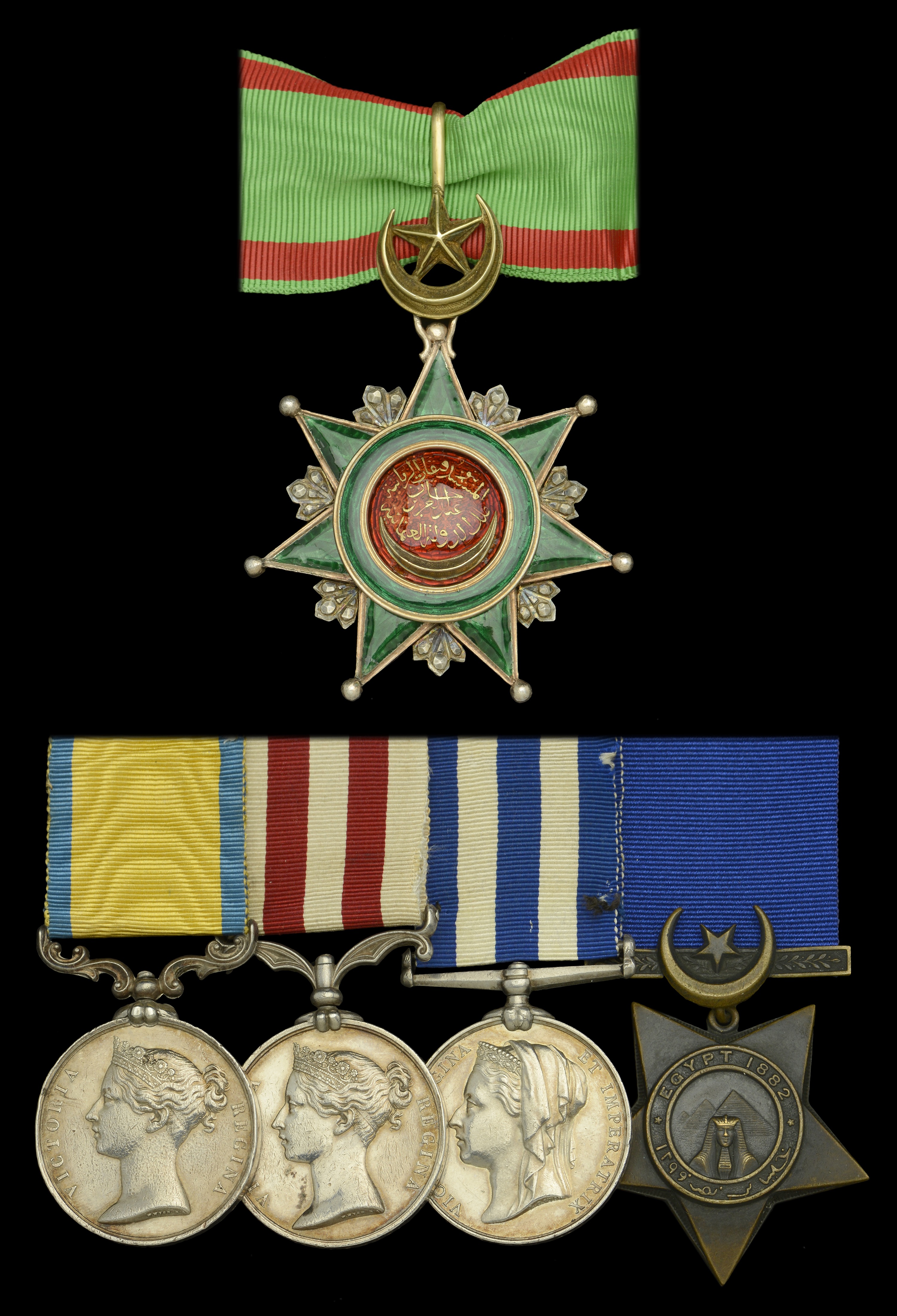An ‘Egyptian campaign 1882’ Ottoman Order of Osmanieh group of five awarded to Captain C. E. Foot, Royal Navy, who served in H.M.S. Pearl’s Naval Brigade during the Indian Mutiny for which services he was three times Mentioned in Despatches, and later did good service in suppressing the salve trade off the East Coast of Africa, ultimately serving as British Consul at Lake Nyassa Baltic 1854-55, unnamed as issued; Indian Mutiny 1857-59, no clasp (Midn. Chas. C. Foot. Pearl.); Egypt and Sudan 1882-89, dated reverse, no clasp (Capt: C. E. Foot. R.N. H.M.S. “Ruby.”); Ottoman Empire, Order of Osmanieh, Third Class neck badge, silver, silver-gilt, and enamel, with neck riband; Khedive’s Star, dated 1882, unnamed as issued (5) £2,600-£3,000 --- Approximately 261 no clasp Indian Mutiny medals awarded to H.M.S. Pearl. Approximately 234 no clasp medals awarded to H.M.S. Ruby. Ottoman Order of Osmanieh, Third Class London Gazette 16 January 1883: ‘In recognition of distinguished services before the Enemy during the late Campaign in Egypt.’ Charles Edward Foot was born at Vicarsfield, County Kilkenny, Ireland, on 29 July 1841 and joined the Royal Navy as a Cadet on 15 February 1855, serving in H.M.S. Hawke from that date to 19 May 1856, seeing active service in this ship during the Baltic campaign. Transferring to H.M.S. Pearl on 20 May 1856, he was appointed Midshipman on 14 February 1857, and saw further service as part of the Naval Brigade in India during the Great Sepoy Mutiny, for which services he was three times Mentioned in Despatches by Captain Edward Sotheby, R.N., Commanding Pearl’s Naval Brigade (London Gazettes 15 June 1858, 18 June 1858, and 2 July 1858) the first time for the action with the rebels at Thamowlee on 17 April 1858, the second time for the action with the enemy at Puchawas on 25 April 1858, and the third time his services during the action at Nuggur on 29 April 1858: ‘Lieutenant Grant, assisted by Mr. C. E. Foot, Midshipman, managed the guns, which were so well directed by their captains, that only one shell out of 35 failed in striking the object.’ Promoted Lieutenant on 16 February 1861 and Commander on 25 October 1867, Foot commanded H.M.S. Daphne from 1 November 1873 to 13 March 1876, in suppression of the slave trade off the east coast of Africa. Amongst other success on 13 March 1874 they captured a slave dhow on the north-west coast of Madagascar, with 225 slaves onboard, and towards the end of his period of command he ‘did good service in the Persian Gulf, and quelled an armed insurrection by his energy and promptitude. He was fortunate enough to make the leader [the ex-Sultan of Muscat] prisoner.’ (The Standard, 6 January 1876 refers). For his services he received the thanks of the Commander-in-Chief and the Government of India. Promoted Captain on 31 December 1875, Foot subsequently served as post-Captain of the unarmoured composite corvette H.M.S. Ruby from 12 May 1880 to 16 December 1882, seeing active service in command of this ship during the Egyptian campaign of 1882. In recognition of his services during the Egyptian campaign, he was appointed to the Third Class of the Order of Osmanieh, and the entire crew were awarded 14 days’ special leave by the Admiralty. Transferring to the Half-Pay List on 16 December 1882, he was appointed by the Foreign Office as British Consul in the territories of the African chiefs in the districts adjacent to Lake Nyassa, ‘for the purpose of suppressing the slave trade and developing civilisation and commerce in Central Africa’. He died in Mozambique on 16 August 1884. Sold with copied service record, medal roll extracts, and copied research.


